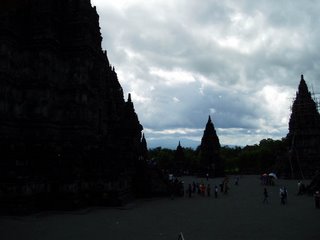Breathing Nusantara

It strikes you before too long. You peer around, near and afar, along the main roads and alleys. You move from urban to rural to urban again, but it’s scarce. It’s just not easy finding a clump of lallang when in Central Java. Land gets no spare change here.
The earth is constantly worked, rejuvenated and reworked; sawah padi, sugarcane fields, rivers, parit, settlements in the form of cities, shanties and villages. Just about every square inch matters in this contiguous weave of human activity and nature.
I spent four days in Central Java and merely brushed its beautiful lashes. Central Java, as sopan as they come, intoxicates with its quintessential cycles. You feel it in your bones. You smell it in the air after the rain. The rivers murmur ancient stories from the deep ravines they carved in time’s bed.
In the rice-fields, the mud basins bear generations of paddy in different stages of growth. In one segment you see tanned stalks of grain, in the next they are merely saplings. Irrigation must have enabled this capacity for year-round planting. The sawah is everywhere; it comes right up to the road shoulder, wraps around houses and courtyards, punctuates vacant plots in urban Yogya, and sweeps for miles terrace upon terrace towards the mountainous folds.
Every few years or so, the active volcanoes in the region take turns to burp. Sometimes it’s a mild clearing of the throat. Sometimes it erupts. Gunong Merapi, 35km from Yogyakarta, is next. Volcanologists say it’s a sure thing. In fear and trembling, in reverence, the locals await the episode. It is a good thing, they know. The rich organic payload from volcanoes such as Gunong Merapi have for centuries churned their land, renewing it with freshness. It is like spring. It is the hand of Lord Siva – with destruction comes rebirth. The cycle will continue.
Coupled with predictable rainfall and graced with gentle slopes which rise suddenly into mountains, it begins to explain why Central Java has played host to some of the oldest civilizations in the region and is today one of the most populous regions in the world. The Java Man (Homo erectus) was found at Sangiran. He is believed to be 700,000 years old.
Dynasties made their seat here as well. Sailendra, Majapahit, Mataram, it’s a long list with deep knowledge and technology. Just about the time they were building the earlier temples of the Khmer Empire at Roluos, east of Angkor (circa 877-889), the Buddhists in Central Java had completed their magnum opus, Borobudur (750-842).

Preah Ko and Lolei of the Roluos group of temples were built from clay bricks and local stucco; Borobudur, on the other hand is a ten-terrace temple constructed of stone complete with sophisticated strategies for stormwater drainage in the form of gargoyles. About 50 km east, the Hindus too did their testament in stone with the temple complex of Prambanan.
All these finished between the 8th and 9th centuries. That’s mind-boggling. Something in your head spins when the bus passes through the town of Magelang. It is a pretty town, saddled between two mountain ranges, distinctly Javanese where the buildings are constructed of masonry walls rather than the wooden kampong archetypes we are familiar with in Malaysia. There are street banners everywhere. Seems that Magelang is celebrating its anniversary. The banners read: Selamat Menyambut Harijadi Magelang Ke 1100.
That takes a while to register – 1,100 years of continued inhabitation is a long, long time. Here in babyland Petaling Jaya, people such as my sister comment that the SS2 neighborhood is old. This ought to give her some perspective.
The story of Central Java is an intricate tikar of a hundred stories, a Ramayana in its own right. Millions have laid their prints on its ever-churning soil leaving behind their bones and spirit – from the Java Man, through the great Sailendra and Majapahit dynasties, through the arrival of Admiral Cheng Ho’s fleet in Semarang, through the wave of Islam at Demak, through the Dutch VOC, through the Japanese Occupation, through the writings of Pramoedya Ananta Toer to the bechak riders of Malioboro Street today.
I spent four days in Central Java and peeked at only a passage of its Earth Sutra. I do not understand it, cannot grasp its dimension, but I feel it. I feel deeply about it.
No comments:
Post a Comment